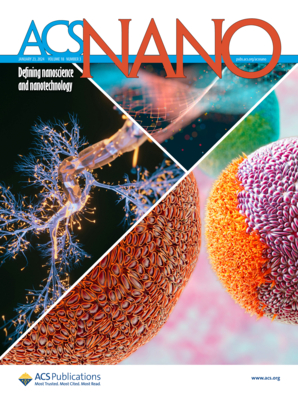Multiplexed Ultrafast Photothermal Digital Polymerase Chain Reaction Based on Oligo(Phenylene-Ethynylene).
IF 15.8
1区 材料科学
Q1 CHEMISTRY, MULTIDISCIPLINARY
引用次数: 0
Abstract
Periodontal disease results from an imbalance between bacterial complexes and the immune system. However, periodontal disease diagnosis is limited by its time-consuming nature, long processing time, and high costs. In this study, we suggest an ultrafast, highly sensitive, and multitargeted plasmonic photothermal-based digital polymerase chain reaction (dPCR) method using a novel plasmonic photothermal-based dPCR chip combined with photothermal materials and organic interfacial chemicals for periodontal disease diagnosis. This platform can detect biofilm-forming bacteria (Streptococcus mutans), red complex bacteria (Porphyromonas gingivalis), and orange complex bacteria (Campylobacter rectus and Prevotella nigrescens). The ultrafast plasmonic photothermal-based dPCR technique amplified multiple target genes over 45 cycles within 14 min, and a fluorescence scanning system measured the fluorescence intensity within 9 min. The sensitivity of detection of standard bacteria and artificial saliva containing bacteria showed a sensitivity of 101 copies/μL. Furthermore, multiplex PCR was performed with a plasmonic photothermal-based dPCR device to confirm the possibility of multiplex PCR of bacterial mixtures containing four species. This plasmonic photothermal-based dPCR platform can be utilized as a point-of-care molecular diagnostic device for the ultrafast diagnosis of diseases in real-time in various fields.基于低聚苯乙烯的多路超快光热数字聚合酶链反应。
牙周病是由细菌复合体和免疫系统之间的不平衡引起的。然而,牙周病的诊断因其费时、处理时间长、费用高而受到限制。在这项研究中,我们提出了一种超快速、高灵敏度、多靶点的基于等离子体光热的数字聚合酶链反应(dPCR)方法,该方法使用一种新型的基于等离子体光热的dPCR芯片,结合光热材料和有机界面化学物质用于牙周病诊断。该平台可检测生物膜形成菌(变形链球菌)、红色复合菌(牙龈卟啉单胞菌)、橙色复合菌(直弯曲菌和黑化普雷沃菌)。基于超快等离子体光热的dPCR技术在14 min内扩增了45个循环,荧光扫描系统在9 min内测量了荧光强度。检测标准菌和含菌人工唾液的灵敏度为101拷贝/μL。此外,用等离子体光热dPCR装置进行多重PCR,以证实含有四种细菌混合物的多重PCR的可能性。该基于等离子体光热的dPCR平台可作为一种点对点分子诊断设备,在各个领域实现疾病的实时超快速诊断。
本文章由计算机程序翻译,如有差异,请以英文原文为准。
求助全文
约1分钟内获得全文
求助全文
来源期刊

ACS Nano
工程技术-材料科学:综合
CiteScore
26.00
自引率
4.10%
发文量
1627
审稿时长
1.7 months
期刊介绍:
ACS Nano, published monthly, serves as an international forum for comprehensive articles on nanoscience and nanotechnology research at the intersections of chemistry, biology, materials science, physics, and engineering. The journal fosters communication among scientists in these communities, facilitating collaboration, new research opportunities, and advancements through discoveries. ACS Nano covers synthesis, assembly, characterization, theory, and simulation of nanostructures, nanobiotechnology, nanofabrication, methods and tools for nanoscience and nanotechnology, and self- and directed-assembly. Alongside original research articles, it offers thorough reviews, perspectives on cutting-edge research, and discussions envisioning the future of nanoscience and nanotechnology.
 求助内容:
求助内容: 应助结果提醒方式:
应助结果提醒方式:


